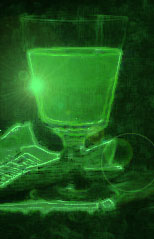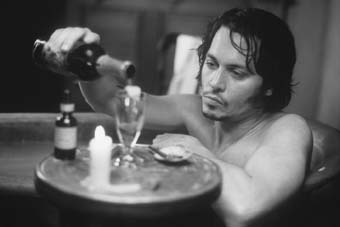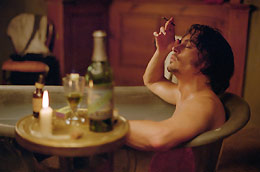


1.
The scientific explanation
[from www.encyclopedia.com]
Absinthe
(ăb´sinth) , an emerald-green, toxic liqueur distilled from wormwood and other aromatics, including angelica root, sweet-flag root, star anise, and dittany, which have been macerated and steeped in alcohol. It was invented by a Dr. Ordinaire, a Frenchman who lived in Switzerland. Genuine absinthe is 70% to 80% alcohol. Because it caused harmful neurological effects, absinthe was banned in many countries; where it still is available it is no longer as toxic as it once was.
Wormwood
Mediterranean perennial herb or shrubby plant ( Artemisia absinthium ) of the family Asteraceae ( aster family), often cultivated in gardens and found as an escape in North America. It has silvery gray, deeply incised leaves and tiny yellow flower heads. Wormwood oil has been utilized since ancient times as an insect repellent, particularly for moths; until recently it was used for intestinal worms and for other medicinal purposes. It was also employed in brewing but is best known for its bitter principle, which is an important ingredient of absinthe ; the compound alpha-thujone, found in wormwood, formerly gave that liqueur its toxicity. Because of its bitter taste the common wormwood has long symbolized human rancor and is often so represented in the Bible.
2.
The (almost) whole story
Absinthe is a bitter green liquor containing large amounts of anise and wormwood (artemesia absentium). It has a very high alcohol content, and there its primary power comes from. It can be classified as both a narcotic and a liquor. The effects are euphoria along with psychedelia, and a (supposed) ability to incite artistic creativity. Because of the bitterness and high % of alcohol, it is always prepared in a mixture of 50% sugar water.
The gothic and romantic literary movements were closely associated with absinthe; as were the symbolists, surrealists, expressionists and impressionists in the galleries. In fact, many people we look up to were frequently absinthe drinkers: Picasso, Poe, Baudelaire, Oscar Wilde, Gauguin, Van Gogh, Degas, Manet, and many others. Some even created their greatest masterpieces under its influence.
Though it appeared as a medicinal concoction throughout the middle ages, it was popularized by Dr. Pierre Ordinaire in 1792 as a tonic. Soon, companies like Pernod sprang up and promoted its recreational virtues. It became the favored drink of decadent artists, and then was produced more cheaply (and unsafely) for the masses. A whole culture sprang up in the cafés of Europe as a response. Absinthe enthusiasts dubbed it "the green fairy", whereas opponents of it dubbed it "the green devil".
Absinthe became extremely popular in France; a dramatic surge in alcoholism, a horde of nervous wine interests, and an international propaganda campaign from the temperence movement were the negative results of its unprecedented success. Wine producers blamed the wormwood rather than the alcohol for the rowdy and destructive drunkards, and thereby ducked the worst of the attacks of the prohibitionists. Politicians around the world bent with the wind, and began to proactively ban absinthe, before any verifiable medical studies were completed. The wine-makers were reassured that their industry would survive without serious competition, and the temperence movement claimed its first major victory. Popular absinthe makers dropped the wormwood and upped the anise content, resulting in the modern day liquors of Pernod, Ricard and Herbsaint.
Absinthe has a magificent legacy, and it appears that more still remains to be written about la fée verte.
[THANKS TO WWW.NYCGOTH.COM]
3.
Where do I know it from?
"From Hell"
Inspector Abberline treats himself to an Absinthe-Laudanum cocktail.


"Dracula"
In Bram Stoker's Dracula, the Count takes Mina to a bar to have a glass of Absinthe.
Artwork
Look at the painting "Absinthe" by Degas:
http://www.ibiblio.org/wm/paint/auth/degas/absinthe/degas.absinthe-2.jpg
4.
Where can I get it?
Today, though legal enforcement is relatively lax, it is illegal to sell or import absinthe. However, all of it's ingredients (including wormwood) are legal, and so several recipes exist on the web. Still, most of these formulae are unable to adequately mimic the unique taste and effects of manufactured absinthe, which can only be obtained today in Prague and parts of Spain.
Pernod, Baileys and Herbsaint are of course available worldwide.